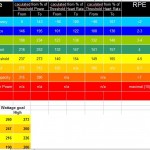 You hear the word “Zone” a lot in training. No, we’re not talking about “I’m in the zone” (well you DO hear that but that’s not what we’re talking about here. We’re talking about training zones.)
You hear the word “Zone” a lot in training. No, we’re not talking about “I’m in the zone” (well you DO hear that but that’s not what we’re talking about here. We’re talking about training zones.)
Zone training is very important for athletes past 50, so it is essential to know a little bit about zones.
What Are The Training Zones?
This definition agrees with most training authorities for what the “zones” are called:
- Zone 1: Active Recovery
- Zone 2: Endurance Pace
- Zone 3: Tempo (or Race Pace)
- Zone 4: Lactate Threshold (LT)
- Zone 5: Anaerobic Capacity (VO2 Max)
Some may break some of them in to more zones, but this definition will go along way with most people.
How are the Zones Measured?
Two common ways of measuring level of effort (determines which Zone you are in) are measuring heart rate (HR) and critical power output (CP). For runners, it is very difficult to determine power so they use almost exclusively heart rate.
To compute heart rate zones we need two starting points – resting heart rate and maximum heart rate. Understand that both these numbers are subject to change, and most likely will change due to exercise. Once you have the max and the minimum, the Heart Rate Range is defined as the difference between the two. Zones are defined by percentages within the range. Here is a “working” guide which is OK until you get with a trainer and determine your actual zones:
- Zone 1: 0-50% Recovery
- Zone 2: 50-65% Endurance
- Zone 3: 65-75% Tempo
- Zone 4: 75-85% Threshold
- Zone 5: above 85% Anaerobic
So, if your resting HR is 80 and your max is 180, your range is 100, and 50% of range would be 80 (resting HR) + 50 (50% of range) = 130 beats per minute.
Power zones are determined by using Critical Power (CP), which is defined as the amount of power you can generate for a specific amount of time at threshold. For example, CP20 is the wattage you can produce for 20 minutes at LT. Again, these numbers will change with training.
A basic power zone calculation would be something like this:
- Zone 1: CP180 – 240 Recovery
- Zone 2: CP120 Endurance
- Zone 3: CP90 Tempo
- Zone 4: CP20 – 60 Threshold
- Zone 5: CP1-5 Anaerobic
By the way, most trainers refer to CP60 as “Functional Threshold Power” or FTP.
Again, we stress that these are beginner guidelines. A certified trainer can give you a treadmill / stationary bike test and test your blood to determine LT or VO2 Max and compute your zones from those results. A typical test costs about $150 in central Florida.